SSANGYONG KORANDO 1997 Service Repair Manual
Manufacturer: SSANGYONG, Model Year: 1997, Model line: KORANDO, Model: SSANGYONG KORANDO 1997Pages: 2053, PDF Size: 88.33 MB
Page 1081 of 2053

SSANGYONG MY2002
4F-98 ABS AND TCS
Color
-
BRN/YEL
WHT/BLK
- Pin
52
53
54Circuit
Not Used
Left Rear Inlet Valve
Right Front Inlet Valve
Not Used
Page 1082 of 2053
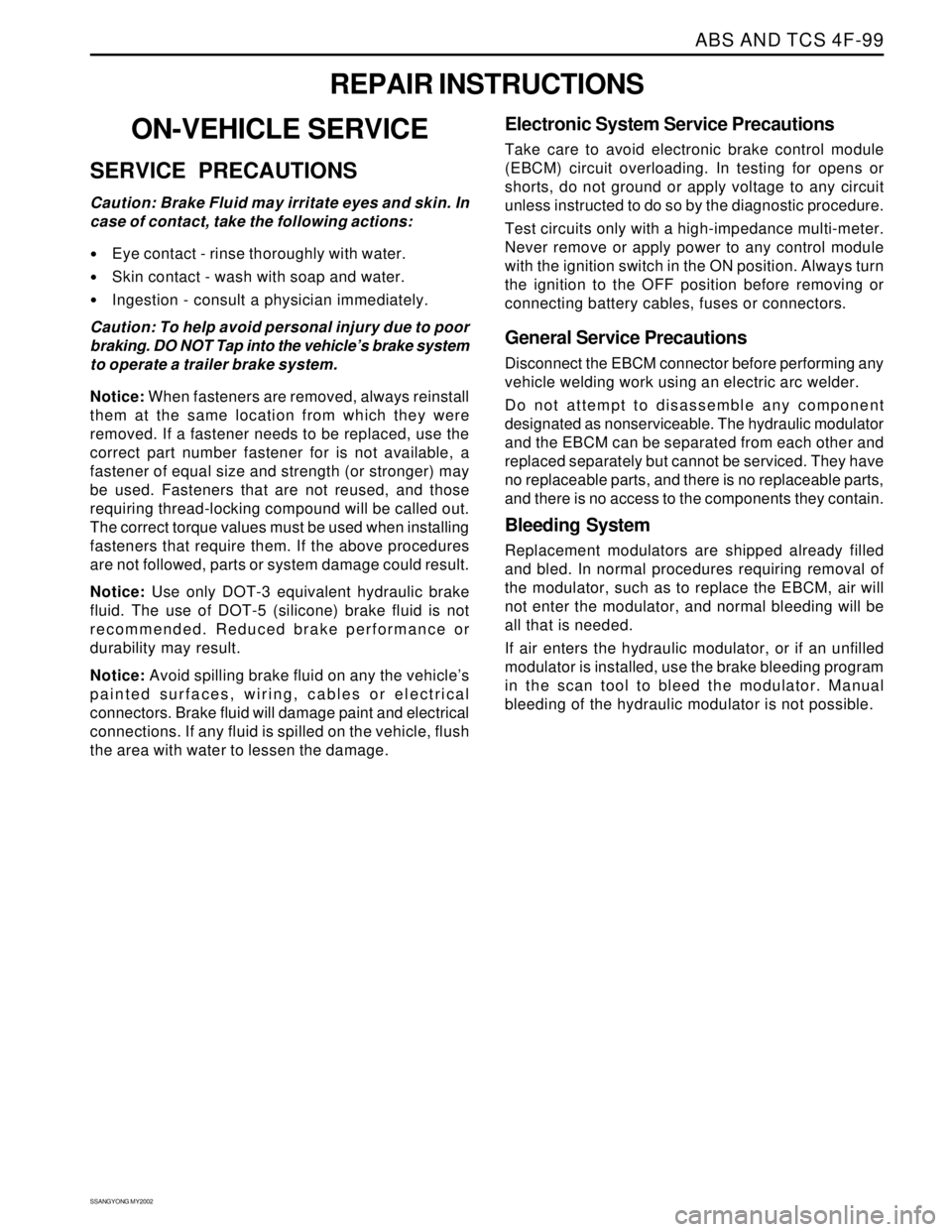
ABS AND TCS 4F-99
SSANGYONG MY2002
REPAIR INSTRUCTIONS
ON-VEHICLE SERVICE
SERVICE PRECAUTIONS
Caution: Brake Fluid may irritate eyes and skin. In
case of contact, take the following actions:
Eye contact - rinse thoroughly with water.
Skin contact - wash with soap and water.
Ingestion - consult a physician immediately.
Caution: To help avoid personal injury due to poor
braking. DO NOT Tap into the vehicle’s brake system
to operate a trailer brake system.
Notice: When fasteners are removed, always reinstall
them at the same location from which they were
removed. If a fastener needs to be replaced, use the
correct part number fastener for is not available, a
fastener of equal size and strength (or stronger) may
be used. Fasteners that are not reused, and those
requiring thread-locking compound will be called out.
The correct torque values must be used when installing
fasteners that require them. If the above procedures
are not followed, parts or system damage could result.
Notice: Use only DOT-3 equivalent hydraulic brake
fluid. The use of DOT-5 (silicone) brake fluid is not
recommended. Reduced brake performance or
durability may result.
Notice: Avoid spilling brake fluid on any the vehicle’s
painted surfaces, wiring, cables or electrical
connectors. Brake fluid will damage paint and electrical
connections. If any fluid is spilled on the vehicle, flush
the area with water to lessen the damage.
Electronic System Service Precautions
Take care to avoid electronic brake control module
(EBCM) circuit overloading. In testing for opens or
shorts, do not ground or apply voltage to any circuit
unless instructed to do so by the diagnostic procedure.
Test circuits only with a high-impedance multi-meter.
Never remove or apply power to any control module
with the ignition switch in the ON position. Always turn
the ignition to the OFF position before removing or
connecting battery cables, fuses or connectors.
General Service Precautions
Disconnect the EBCM connector before performing any
vehicle welding work using an electric arc welder.
Do not attempt to disassemble any component
designated as nonserviceable. The hydraulic modulator
and the EBCM can be separated from each other and
replaced separately but cannot be serviced. They have
no replaceable parts, and there is no replaceable parts,
and there is no access to the components they contain.
Bleeding System
Replacement modulators are shipped already filled
and bled. In normal procedures requiring removal of
the modulator, such as to replace the EBCM, air will
not enter the modulator, and normal bleeding will be
all that is needed.
If air enters the hydraulic modulator, or if an unfilled
modulator is installed, use the brake bleeding program
in the scan tool to bleed the modulator. Manual
bleeding of the hydraulic modulator is not possible.
Page 1083 of 2053
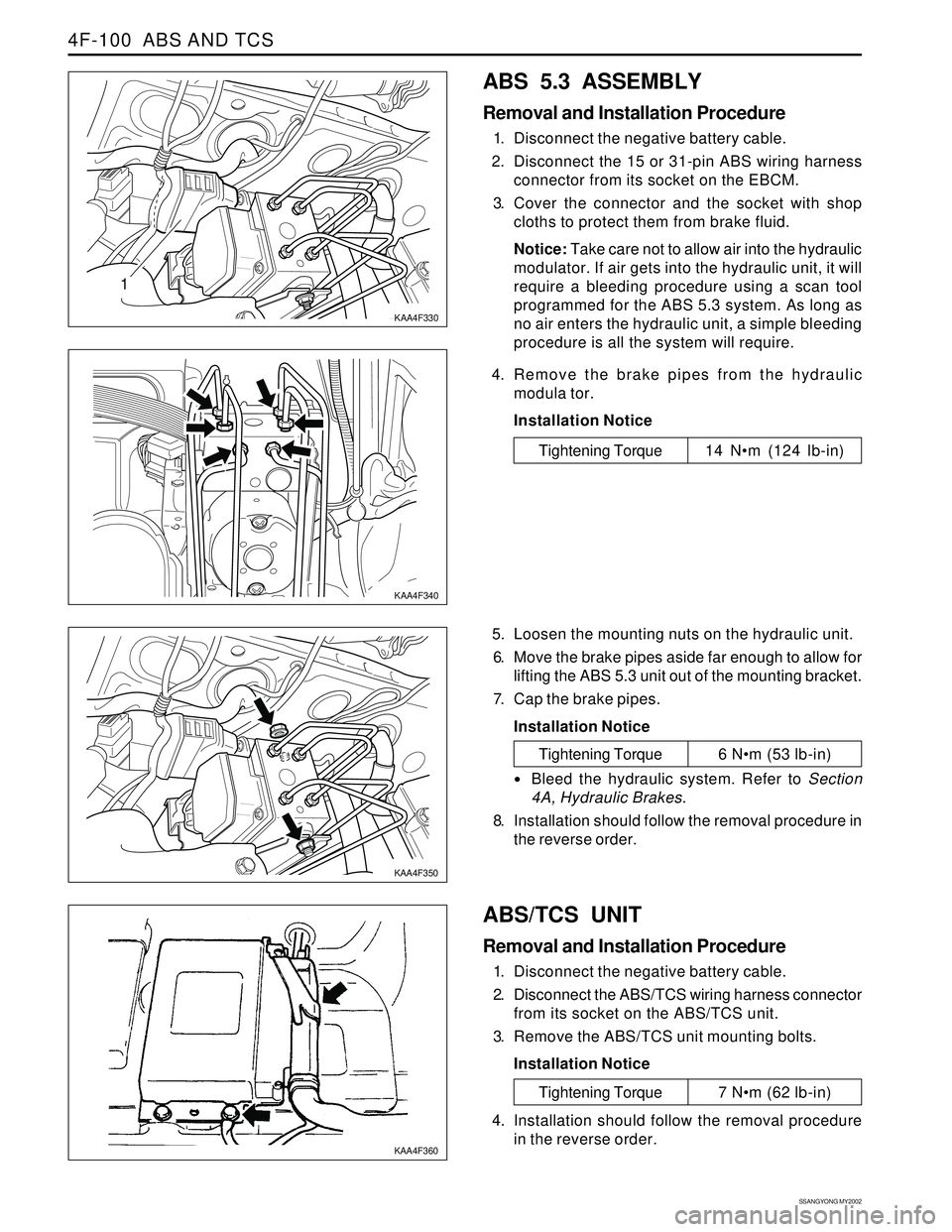
SSANGYONG MY2002
4F-100 ABS AND TCS
1
KAA4F330
KAA4F340
ABS 5.3 ASSEMBLY
Removal and Installation Procedure
1. Disconnect the negative battery cable.
2. Disconnect the 15 or 31-pin ABS wiring harness
connector from its socket on the EBCM.
3. Cover the connector and the socket with shop
cloths to protect them from brake fluid.
Notice: Take care not to allow air into the hydraulic
modulator. If air gets into the hydraulic unit, it will
require a bleeding procedure using a scan tool
programmed for the ABS 5.3 system. As long as
no air enters the hydraulic unit, a simple bleeding
procedure is all the system will require.
4. Remove the brake pipes from the hydraulic
modula tor.
Installation Notice
Tightening Torque 14 Nm (124 lb-in)
5. Loosen the mounting nuts on the hydraulic unit.
6. Move the brake pipes aside far enough to allow for
lifting the ABS 5.3 unit out of the mounting bracket.
7. Cap the brake pipes.
Installation Notice
ABS/TCS UNIT
Removal and Installation Procedure
1. Disconnect the negative battery cable.
2. Disconnect the ABS/TCS wiring harness connector
from its socket on the ABS/TCS unit.
3. Remove the ABS/TCS unit mounting bolts.
Installation Notice
KAA4F350
KAA4F360
Tightening Torque 6 Nm (53 lb-in)
Bleed the hydraulic system. Refer to Section
4A, Hydraulic Brakes.
8. Installation should follow the removal procedure in
the reverse order.
Tightening Torque 7 Nm (62 lb-in)
4. Installation should follow the removal procedure
in the reverse order.
Page 1084 of 2053

ABS AND TCS 4F-101
SSANGYONG MY2002
FRONT WHEEL SPEED SENSOR
Removal and Installation Procedure
1. Disconnect the negative battery cable.
2. Disconnect the front wheel speed sensor electrical
connector.
3. Raise and suitably support the vehicle.
4. Turn the steering wheel to expose the front wheel
speed sensor. It is located at the rear of the steering
knuckle near tie rod end.
5. Remove the bolt and the front wheel speed sensor
from the steering knuckle.
Installation Notice
KAA4F370
KAA4F380
Tightening Torque 7 Nm (62 lb-in)
6. Installation should follow the removal procedure in
the reverse order.
REAR WHEEL SPEED SENSOR
Removal and Installation Procedure
1. Disconnect the negative battery cable.
2. Disconnect the rear wheel speed sensor electrical
connector. It is located under the rear seat.
3. Raise and suitably support the vehicle.
4. Remove the rear wheel speed sensor.
Installation Notice
KAA4F390
KAA4F400
Tightening Torque 7 Nm (62 lb-in)
5. Installation should follow the removal procedure
in the reverse order.
Page 1085 of 2053

SSANGYONG MY2002
4F-102 ABS AND TCS
ACCELERATION SENSOR
Removal and Installation Procedure
1. Disconnect the negative battery cable.
2. Disconnect the acceleration sensor connector. It
is located at the rear of audio system.
3. Remove the acceleration sensor mounting bolts.
Installation Notice
SYSTEM FUSE
Removal and Installation Procedure
The ABS/TCS system fuse, EF11, is located in the
engine fuse block. Counting from the battery toward
the surge tank, it is the first system fuse in the row.
KAA4F410
KAA4F420
Tightening Torque 7 Nm (62 lb-in)
4. Installation should follow the removal procedure in
the reverse order.
INDICATORS
The indicator lamps ABS and EBD and TCS are part of
the instrument cluster. Refer to Section 9E, instrumenta-
tion/ Driver information, for removal and replacement
details.
Page 1086 of 2053
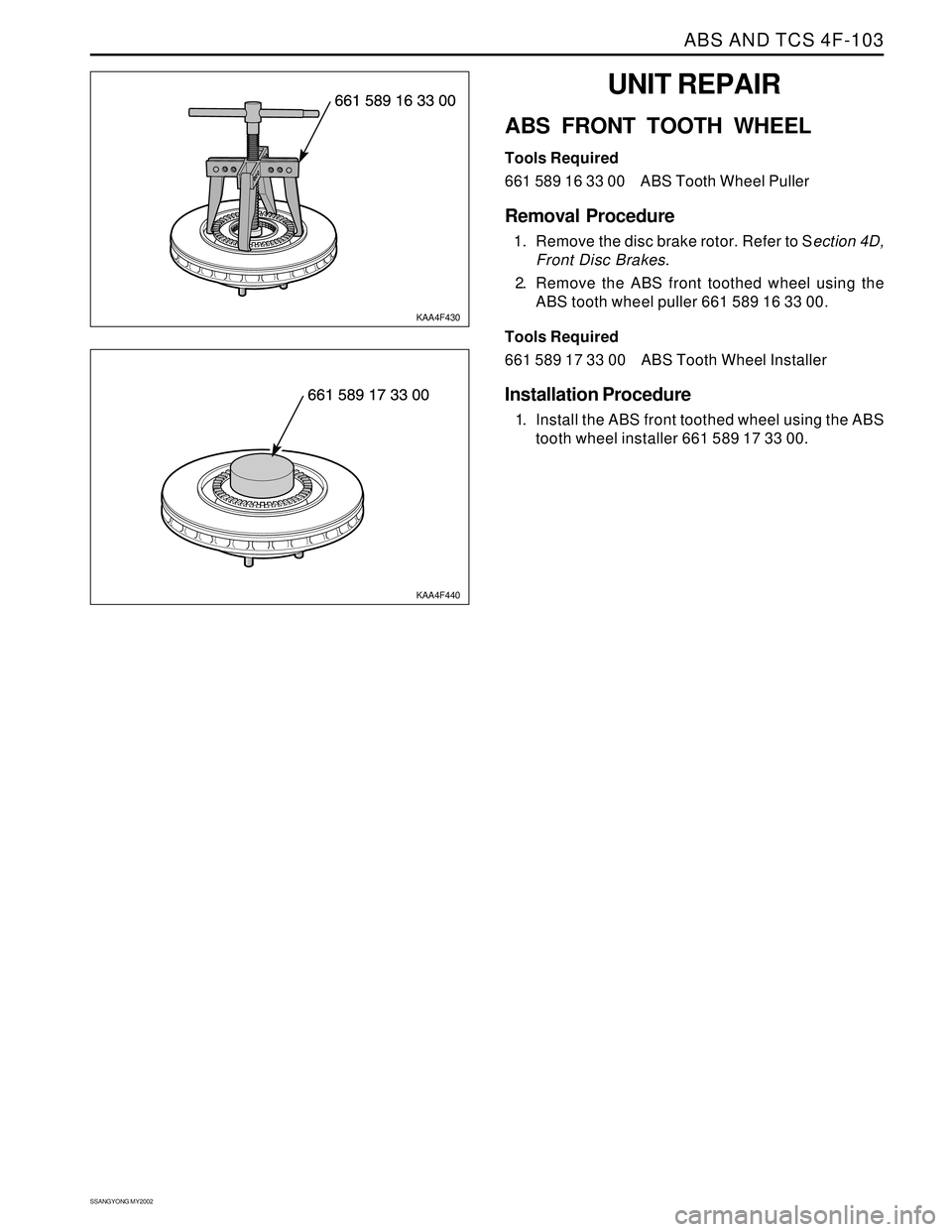
ABS AND TCS 4F-103
SSANGYONG MY2002
UNIT REPAIR
ABS FRONT TOOTH WHEEL
Tools Required
661 589 16 33 00 ABS Tooth Wheel Puller
Removal Procedure
1. Remove the disc brake rotor. Refer to Section 4D,
Front Disc Brakes.
2. Remove the ABS front toothed wheel using the
ABS tooth wheel puller 661 589 16 33 00.
Tools Required
661 589 17 33 00 ABS Tooth Wheel Installer
Installation Procedure
1. Install the ABS front toothed wheel using the ABS
tooth wheel installer 661 589 17 33 00.
KAA4F430
KAA4F440
Page 1087 of 2053

SSANGYONG MY2002
4F-104 ABS AND TCS
SPECIAL TOOLS AND EQUIPMENT
SPECIAL TOOLS TABLE
661 589 16 33 00
ABS Tooth Wheel
Puller661 589 17 33 00
ABS Tooth Wheel
Installer
KAA4F450KAA4F460
Page 1088 of 2053
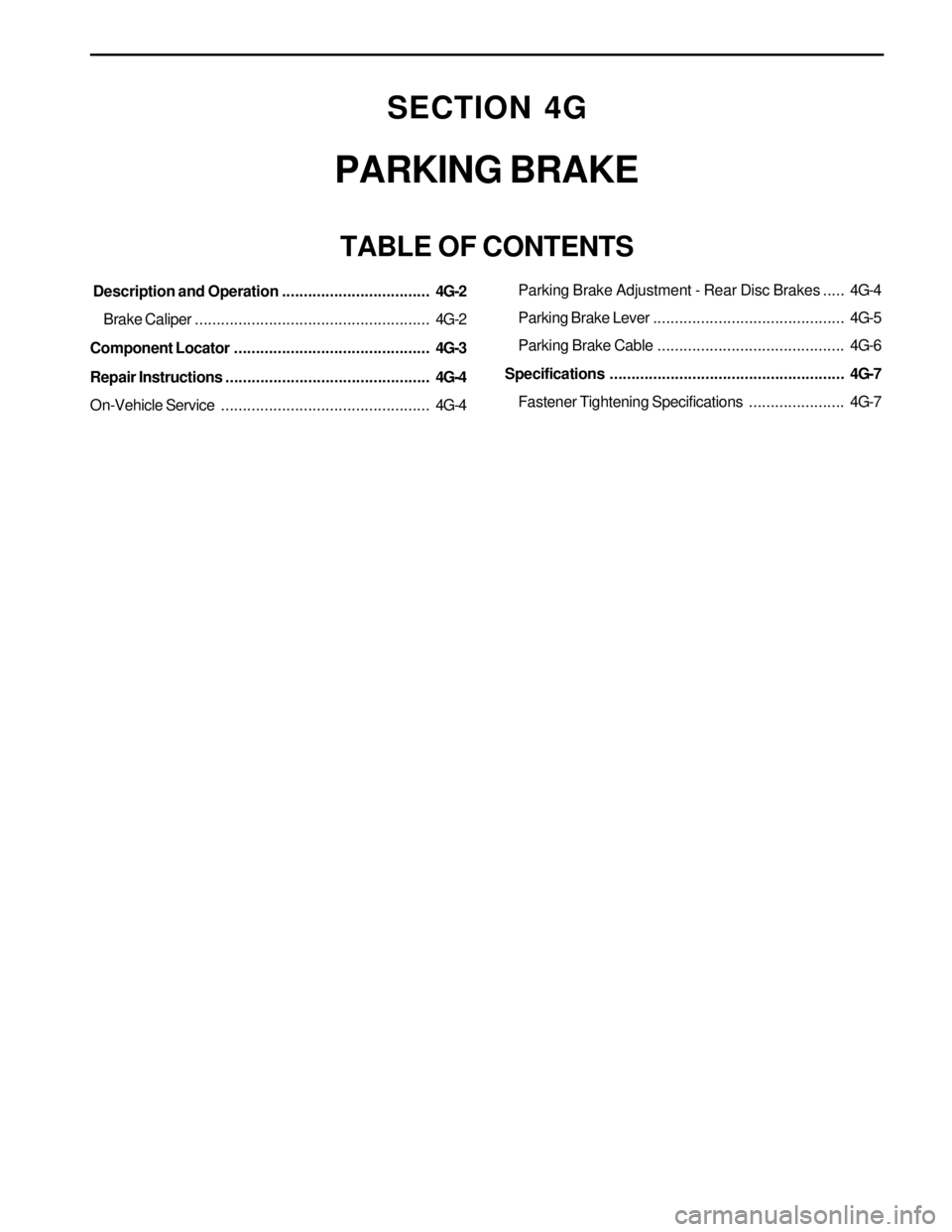
SECTION 4G
PARKING BRAKE
TABLE OF CONTENTS
Description and Operation..................................4G-2
Brake Caliper......................................................4G-2
Component Locator.............................................4G-3
Repair Instructions...............................................4G-4
On-Vehicle Service................................................4G-4Parking Brake Adjustment - Rear Disc Brakes.....4G-4
Parking Brake Lever............................................4G-5
Parking Brake Cable...........................................4G-6
Specifications......................................................4G-7
Fastener Tightening Specifications......................4G-7
Page 1089 of 2053
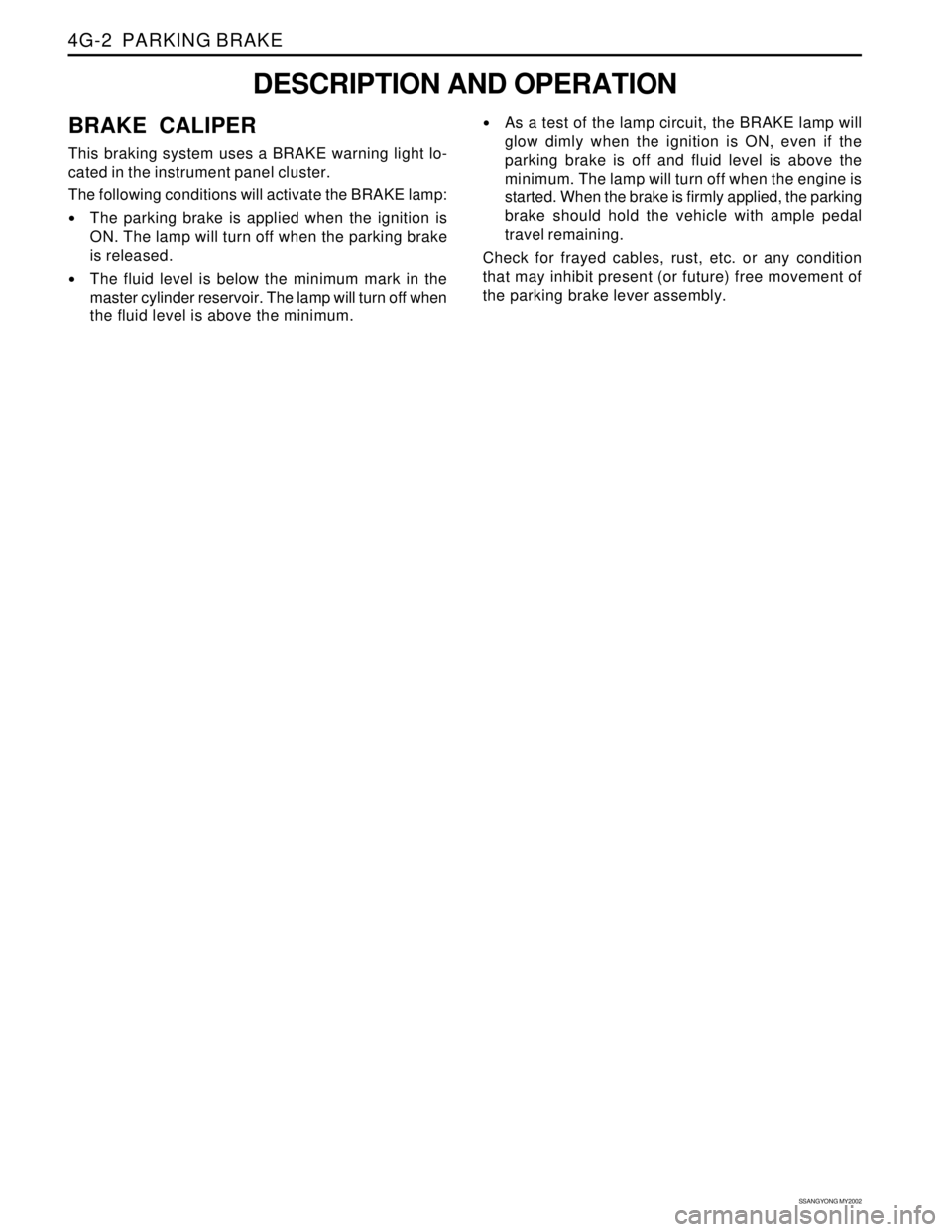
SSANGYONG MY2002
4G-2 PARKING BRAKE
DESCRIPTION AND OPERATION
BRAKE CALIPER
This braking system uses a BRAKE warning light lo-
cated in the instrument panel cluster.
The following conditions will activate the BRAKE lamp:
•The parking brake is applied when the ignition is
ON. The lamp will turn off when the parking brake
is released.
The fluid level is below the minimum mark in the
master cylinder reservoir. The lamp will turn off when
the fluid level is above the minimum.
As a test of the lamp circuit, the BRAKE lamp will
glow dimly when the ignition is ON, even if the
parking brake is off and fluid level is above the
minimum. The lamp will turn off when the engine is
started. When the brake is firmly applied, the parking
brake should hold the vehicle with ample pedal
travel remaining.
Check for frayed cables, rust, etc. or any condition
that may inhibit present (or future) free movement of
the parking brake lever assembly.
Page 1090 of 2053

PARKING BRAKE 4G-3
SSANGYONG MY2002
KAA4G010
COMPONENT LOCATOR
1 Parking Brake Lever
2 Parking Brake Lever Mounting Bolt
3 Front Parking Brake Cable
4 Equalizer5 Adjuster Nut
6 Rear Parking Brake Cable Securing Bolt
7 Rear Parking Brake Cable
8 Rear Disc Brake Rotor